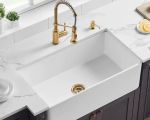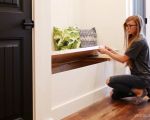How to Remodel a Bathroom with Tile and Stone Accents
As someone who has recently gone through the process of remodeling my own bathroom, I can tell you that adding tile and stone accents can completely transform the space. Whether you're looking to update an outdated bathroom or you want to create a more luxurious, spa-like atmosphere, tile and stone can elevate the design. In this guide, I’ll walk you through the steps to remodel your bathroom using these materials, share tips and tricks I’ve learned along the way, and offer some inspiration to help you get started on your own project.
1. Planning Your Bathroom Remodel
The first step in any bathroom remodel is planning. This includes determining your budget, choosing the materials you want to use, and understanding the layout of your space. Before diving into the tile and stone selection, I recommend taking measurements of your bathroom to ensure you purchase enough materials. For me, this was an eye-opening process because it helped me visualize the final result and avoid overbuying.
a. Budgeting and Setting Realistic Expectations
Setting a realistic budget is crucial for keeping your remodel on track. Tile and stone can be expensive, so it’s important to prioritize areas where these materials will make the most impact. When I remodeled my bathroom, I focused on the shower walls and the floor, as they would benefit the most from the durability and elegance of tile and stone. Don't forget to factor in installation costs, tools, and any other materials you may need, like grout and mortar.
b. Choosing Tile and Stone Materials
There are a variety of tile and stone options available for bathroom remodeling, including ceramic, porcelain, marble, granite, and slate. The key is to choose materials that not only fit your style but also suit the practical needs of your bathroom. For example, I chose porcelain tile for the floor because it's highly durable and water-resistant. For the shower walls, I opted for marble, which added an elegant touch while being easy to clean. Think about the texture, color, and pattern that will work best for your space.
2. Removing the Old Bathroom Fixtures
Once you’ve planned and gathered your materials, the next step is to remove the old fixtures and finishes. This might involve removing old tiles, bathtubs, sinks, or cabinetry. I remember how tedious this process was, but it was also satisfying to see the old elements go and make way for the new design. If you're not comfortable doing this yourself, consider hiring a professional to safely remove the old materials.
a. Preparing the Surfaces
When removing tiles or stone, it’s important to carefully prep the surfaces to ensure proper adhesion for the new materials. Any leftover mortar or adhesives must be cleaned off the walls or floors. I used a scraper and a utility knife to get rid of stubborn bits, making sure the surfaces were smooth and even.
b. Dealing with Plumbing and Electrical Work
Depending on the extent of your remodel, you may need to hire a plumber or electrician to move or install new plumbing and electrical fixtures. I had to move the showerhead and install new lighting fixtures. It’s important to get these professionals involved early in the process to avoid delays or complications later on.
3. Installing Tile and Stone Accents
Now, the fun part begins—installing your tile and stone accents! This step can take time, but the results are definitely worth the effort. I started by laying out the design before applying the adhesive to ensure the tiles fit perfectly.
a. Applying Adhesive and Setting Tiles
Use a notched trowel to apply thin-set mortar to the wall or floor. I found that it’s important to apply a small section at a time so that the mortar doesn’t dry out before you lay down the tiles. Once the adhesive is on, carefully press each tile into place, making sure there’s consistent spacing for grout lines. For stone accents, be sure to check that each piece is level and properly aligned.
b. Cutting Tiles and Stone
During the installation, you’ll likely need to cut tiles or stone to fit around corners or edges. I used a tile cutter for the ceramic tiles and a wet saw for cutting the stone. It’s always a good idea to measure twice and cut once to avoid mistakes.
4. Grouting and Sealing
After the tiles and stone are set and the adhesive has dried, it’s time to grout the spaces between them. Grouting is an essential part of the process because it seals the gaps and prevents water from seeping behind the tiles.
a. Mixing and Applying Grout
I mixed the grout according to the manufacturer's instructions and used a rubber float to spread it over the tiles. Be sure to wipe away any excess grout immediately to avoid hardening on the surface. Let the grout dry for a few hours before wiping the tiles down with a damp sponge.
b. Sealing Stone Accents
Since stone is porous, it’s crucial to apply a sealer to protect the material from stains and moisture. I applied a stone sealant to the marble after grouting, ensuring it was evenly coated and fully absorbed.
5. Installing Bathroom Fixtures
With the tiles and stone accents in place, the final step is to reinstall or replace bathroom fixtures such as the sink, toilet, and shower hardware. I decided to update my fixtures with modern, sleek options to complement the new design. Whether you're installing a new vanity or simply replacing an old faucet, this is the time to bring in the finishing touches that complete your bathroom’s look.
6. Maintenance and Care for Long-Lasting Results
After completing the remodel, I made sure to maintain the tile and stone accents properly to ensure they stay vibrant and beautiful for years to come.
a. Regular Cleaning
Regular cleaning with mild, non-abrasive cleaners is essential for preserving the shine and integrity of tile and stone. For the stone accents, I use a pH-balanced cleaner to avoid damaging the surface. It’s also important to clean up spills immediately to prevent stains.
b. Reapplying Sealant
I also reapply the sealant to the stone every six months to maintain its protection from moisture and stains. This simple step ensures that my stone accents stay beautiful and functional.








